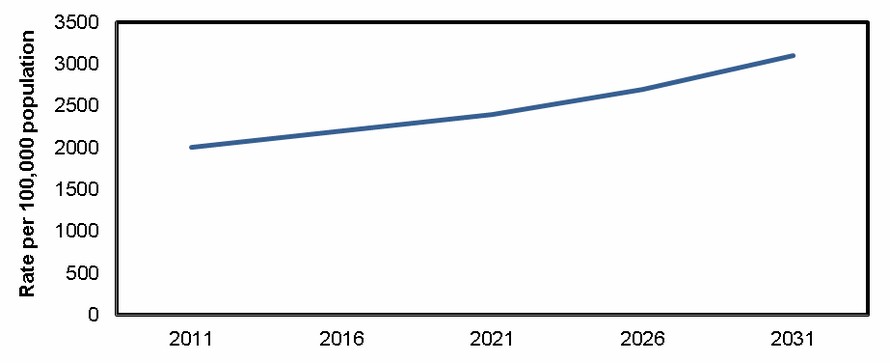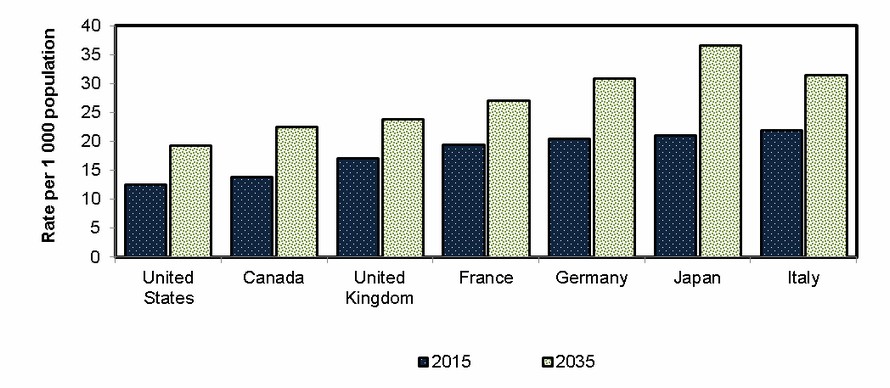Health Status of Canadians 2016: Report of the Chief Public Health Officer - How are we unhealthy? - Dementia
How are we unhealthy?
Dementia
In 2011, an estimated 340,200 or 2% of Canadians aged 40 years and older were living with a diagnosis of dementia.Footnote 1
Alzheimer's disease is the most common form of dementia, representing 60% to 70% of cases.Footnote 2 Common symptoms include memory problems, problems with routine tasks and language, impaired judgement and changes in mood and personality. Symptoms become more severe as the disease progresses.Footnote 3
Over time, by age, by sex
The number of Canadians living with dementia is expected to double in the next 20 years (see Figure 1)Footnote 1.

Text Equivalent
Line graph showing the predicted rates of Canadians living with dementia in 2011, 2016, 2021, 2026 and 2031.
- 2011 = 2000 cases per 100,000 population
- 2016 = 2200 cases per 100,000 population
- 2012 = 2400 cases per 100,000 population
- 2026 = 2700 cases per 100,000 population
- 2031 = 3100 cases per 100,000 population
Rates of dementia increase at a similar rate for men and women until 80 years of age, after which they increase more quickly for women than men. The average age of the onset of symptoms is 70 years for men and 74 for women.Footnote 1
By income
Data on dementia by income are not available at a national level.
Indigenous populations
Limited data are available on dementia for Indigenous populations. Research in 2009 has shown that the age-standardized rate of First Nations living with dementia in Alberta was just under 8 per 1,000 population compared to just under 6 per 1,000 population in non-First Nations Albertans.Footnote 4 Dementia also tended to be diagnosed at an earlier age among First Nations than non-First Nations.Footnote 4
International comparison
Globally, there are an estimated 47 million people living with dementia. This number is expected to nearly triple by 2050 to almost 132 million people.Footnote 5 In 2015, Canada had the second lowest rate of dementia among G7 countries at 14 cases per 1000 (see Figure 2)Footnote 6.

Text Equivalent
Bar chart showing the predicted rate of people living with dementia in G7 countries in 2015 and 2035
2015
- Canada: 13.8 per 1000 population
- United States: 12.4 per 1000 population
- United Kingdom: 17 per 1000 population
- France: 19.3 per 1000 population
- Germany: 20.3 per 1000 population
- Italy: 21.8 per 1000 population
- Japan: 21 per 1000 population
2035
- Canada: 22.5 per 1000 population
- United States: 19.3 per 1000 population
- United Kingdom: 23.7 per 1000 population
- France: 27 per 1000 population
- Germany: 30.9 per 1000 population
- Italy: 31.4 per 1000 population
- Japan: 36.6 per 1000 population
Notes to the reader
- Indigenous populations consist of First Nations, Métis and Inuit.
- G7 countries include seven of the world's industrialized countries, namely the United States, Japan, Germany, France, the United Kingdom, Italy and Canada, that form an informal discussion group and economic partnership.